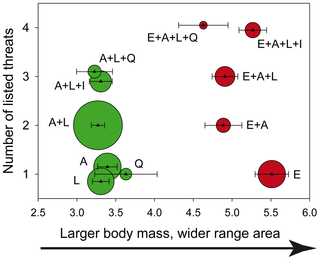 vulnerability traits, threats & co
vulnerability traits, threats & co
research ( species | space | populations | vulnerability | traffic )
There is an urgent need to understand and predict the functional responses of species to anthropogenic change. We aim to improve our understanding of what makes some species more vulnerable than others by exploring the mechanisms by which species traits, anthropic and environmental variables that generate threats and their interaction determine vulnerability to extinction. There is a long tradition of investigating the traits linked with vulnerability. We have focused on some potentially relevant aspects not properly treated so far. One Is the limited and biased data availability that may affect the inference we make. Another is the potential role of trait variability, making species with a higher variability in key traits less prone to extinction. This work has been part of two consecutive research projects in collaboration with Manuela Gonzalez Suarez and Pablo Lucas between others.
González-Suárez M, E Revilla. (2013) Variability in life-history and ecological traits is a buffer against extinction in mammals. Ecology Letters 16:242-251 doi: 10.1111/ele.12035 Editors' Choice in Science
González-Suárez M, PM Lucas, E Revilla. (2012) Biases in comparative analyses of extinction risk: mind the gap. Journal of Animal Ecology, 81: 1211–1222
 Why it is interesting to know how the species at risk are? Because it may help us to identify those before they get into troubles and to identify the processes that interact with the traits, between other things. Together with Manuela Gonzalez Suarez, Pablo Lucas and Ester Polaina we are working on descriptive (predictive) models describing the threatening process by including vulnerability proxies in vertebrates (mostly in mammals) such as species traits including range properties, socioeconomic factors and their interactions. Revealing functional relationships should provide innovative and largely unexplored ways to predict which species may be most affected by changes, and contributes significantly to population biology and biodiversity conservation theory.
Why it is interesting to know how the species at risk are? Because it may help us to identify those before they get into troubles and to identify the processes that interact with the traits, between other things. Together with Manuela Gonzalez Suarez, Pablo Lucas and Ester Polaina we are working on descriptive (predictive) models describing the threatening process by including vulnerability proxies in vertebrates (mostly in mammals) such as species traits including range properties, socioeconomic factors and their interactions. Revealing functional relationships should provide innovative and largely unexplored ways to predict which species may be most affected by changes, and contributes significantly to population biology and biodiversity conservation theory.
González-Suárez M, E Revilla. (2013) Variability in life-history and ecological traits is a buffer against extinction in mammals. Ecology Letters 16:242-251 doi: 10.1111/ele.12035 Editors' Choice in Science
González-Suárez, M; Gómez, A, Revilla, E (2013) Which intrinsic traits predict vulnerability to extinction depends on the actual threatening processes. Ecosphere 4:76
Ideally, if the traits identified are relevant, we would expect that similar species may respond to similarly to the same external threatening factors. This is a very strong assumption, which has so far received not much attention. We hypothesize that the simultaneous consideration of species traits and threats (spatial- and species-based approaches) would provide a more comprehensive understanding of risk of extinction, and will have a higher explanatory and predictive power. We are investigating these by exploring which threats are relevant, and how those threats accumulate along a conceptually plausible endangerment process. The first results are very promising. More work to come by the same team!!
González-Suárez, M; Revilla, E (2014). Generalized drivers in the mammalian endangerment process. PLoS ONE 9: e90292
González-Suárez, M; Gómez, A, Revilla, E (2013) Which intrinsic traits predict vulnerability to extinction depends on the actual threatening processes. Ecosphere 4:76
Polaina E, M González-Suarez, E Revilla (2015). Socioeconomic correlates of global mammalian conservation status. Ecosphere in press
